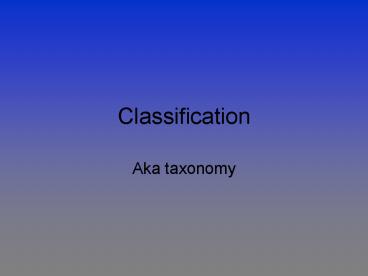Classification - PowerPoint PPT Presentation
1 / 20
Title: Classification
1
Classification
- Aka taxonomy
2
What is taxonomy?
- Developed by Carolus Linnaeus
- The science of identifying, classifying and
naming living things. - Groups living things together by their physical
similarities.
3
How does it work?
- Organisms are classified from groups that are
general into groups that are more specific. - From largest to smallest these groups
are kingdom phylum class order family genus speci
es - The genus and species together make up an
organisms scientific name.
4
Which animal is this?
Kingdom Animalia Its an animal
Phylum Chordata Its an animal with a backbone
Class Mammalia It has a backbone and gives birth
to live young
Order Carnivora It has a backbone and gives birth
to live young and has specialized teeth for
tearing meat
Family Felidae Member of the cat family.
Genus Felis Cats that cant roar
Species domesticus A specific member of the Genus
Felis
This is the classification of a housecat from
general (kingdom) to specific (species)
5
Kingdoms
- Every living thing is classified into one of 6
kingdoms.
Plantae
Animalia
These kingdoms are
Fungi
Protista
Archaebacteria
Eubacteria
6
Kingdom Monera
- Kingdoms Eubacteria and Archaebacteria are
sometimes combined into this one kingdom. - All members of this kingdom are unicellular
- All members of this kingdom are prokaryotic.
7
Kingdom Plantae
- All members of this kingdom are multicellular.
- All members of this kingdom are producers.
- All members of this kingdom are eukaryotic.
8
Kingdom Fungi
- All members of this kingdom are eukaryotic.
- Most members of this kingdom are multicellular.
- All members of this kingdom are decomposers.
9
Kingdom Protista
- All members of this kingdom are eukaryotic.
- Most members of this kingdom are unicellular.
- Members of this kingdom can be producers,
consumers or decomposers.
10
Kingdom Animalia
- All members of this kingdom are multicellular.
- All members of this kingdom are consumers.
- All members of this kingdom are eukaryotic.
11
Animals
- All animals fit into one of two groups
vertebrates and invertebrates. - Every animal belongs to one of nine phyla
12
Phylum Porifera
- Means full of pores
- Sponges
- Simplest of all animals.
- Eat by filtering food through their pores.
13
Phylum Cnidaria
- Means nettle
- Animals that have specialized stinging cells.
- Have basic nerves.
- Jellyfish and sea anemones.
14
Phylum Platyhelminthes
- Flatworms
- Have the beginning or a nervous system
15
Phylum Nematoda
- Roundworms
- All members of this phylum are parasitic.
- Have a simple nervous system.
16
Phylum Annelida
- Worms that have a body of repeating segments.
- Have a brain and circulatory system.
- Earthworms and leeches.
17
Phylum Mollusca
- All mollusks have a soft body.
- Some mollusks are protected by a shell.
- Have a circulatory system and a more complex
nervous system. - Octopus, snail and clam.
18
Phylum Arthropoda
- Means jointed foot
- Largest group of animals on earth.
- Have jointed limbs.
- Have segmented bodies
- Have an exoskeleton.
- Have a head and brain.
- Spiders, crabs, insects
19
Phylum Echinodermata
- Means spiny skin
- Have an endoskeleton
- Have a water vascular system.
- Sea stars
20
Phylum Chordata
- Have a spinal cord, which is part of an advanced
nervous system. - Almost all chordates are vertebrates.
- All vertebrates have a bony skeleton.
- Includes fish, amphibians, reptiles, birds and
mammals.































